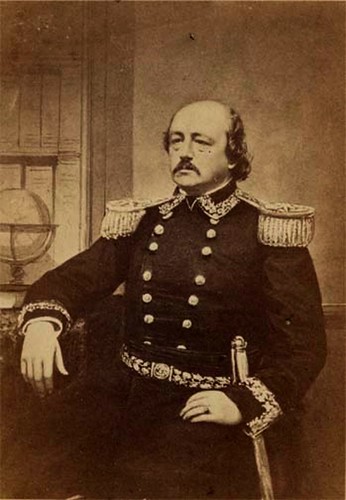Ben Butler saves Washington, Part II

Yesterday I wrote about how, in the days following the April 19, 1861 riot in Baltimore that cut off Washington, DC from New England and the Atlantic states, General Benjamin Butler of Lowell opened a new line of communications to Washington by going through Annapolis. A long-term solution required the Baltimore route to be open, however, so General Winfield Scott, the top army commander, began organizing a military takeover of Baltimore, a mission he estimated would require 12,000 troops. Ben Butler thought otherwise.
Butler’s success in opening the Annapolis route had prompted Scott and President Lincoln to name the Lowell general commander of a newly formed Department of Annapolis with a mission of overseeing the rail route into Washington. Interpreting his orders expansively, Butler soon cast his eyes on Baltimore, both for its strategic importance and out of a sense of vengeance for the city’s treatment of the Lowell-based Sixth Regiment on April 19.
At 2 am on May 5, Butler, on his own initiative, loaded the Sixth Regiment on a train at Annapolis Junction (the point 20 miles inland from Annapolis where the rail line from that city joined the one running from Baltimore to Washington – today known as Fort Meade) and drove up to another rail junction called Relay House that was just 9 miles south of Baltimore. The Sixth seized this key junction and the surrounding hills. Butler was tightening the noose around Baltimore.
A week later, on May 13, Butler mobilized the Sixth Regiment for another mission. As darkness fell, the train bearing the Sixth headed west out of Relay House as if traveling to Harper’s Ferry which was then held by the Confederates. This was a ruse by Butler to mislead Confederate-leaning observers. Some distance out of Relay House, Butler ordered the train to reverse direction and it quietly backed up to Relay House and continued backing up until it rolled into Camden Station in Baltimore, arriving well after dark. An intense spring storm with driving rain and intense thunder and lightning struck Baltimore at the same time, driving almost all of the city’s residents indoors. Butler and the Sixth dismounted the train and quietly marched through the storm to Federal Hill, the highest and most strategic spot in the city. When the people of Baltimore awoke the next morning, they were stunned to discover a regiment of Northern troops in control of the city. Butler took control of the city and began arresting pro-secessionist leaders, imprisoning them in Fort McHenry. This action allowed the many Maryland residents sympathetic to the Union to step forward and take charge. Baltimore and Maryland would never again waiver from the Union cause.